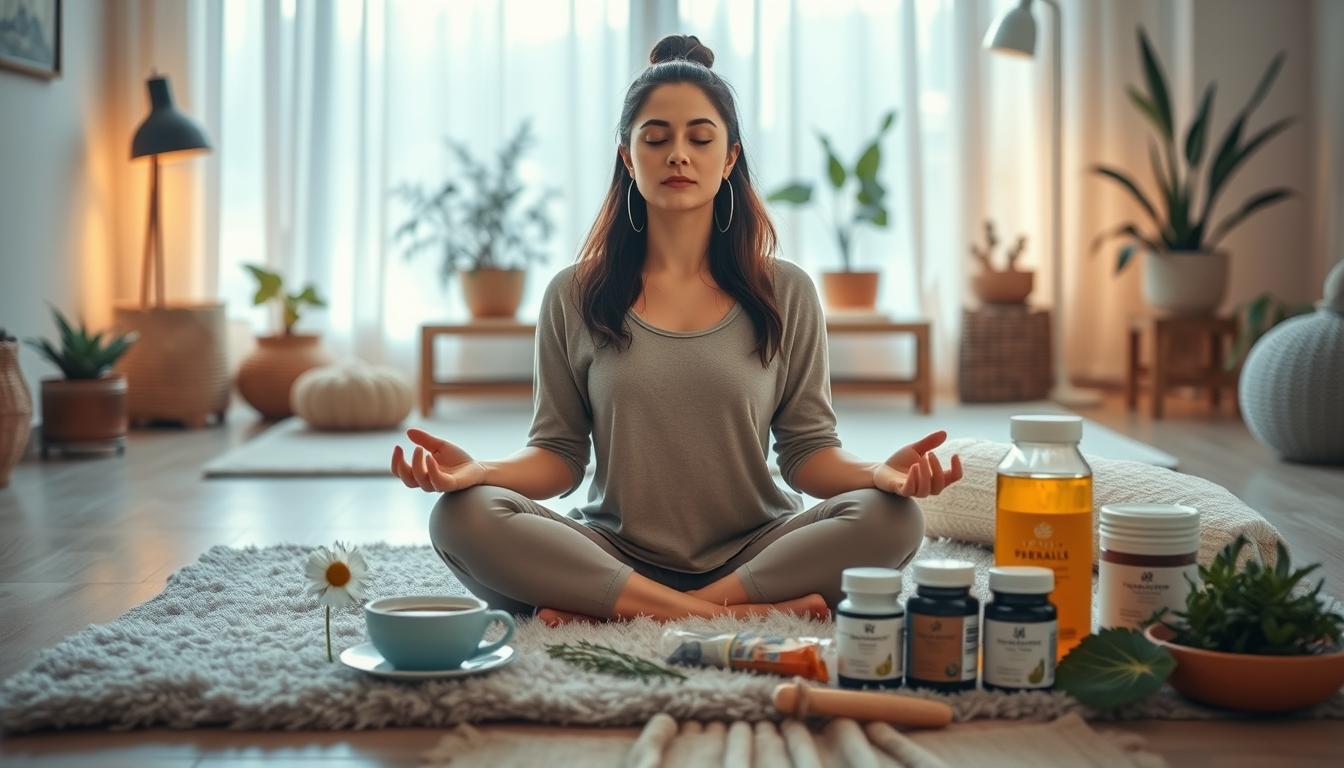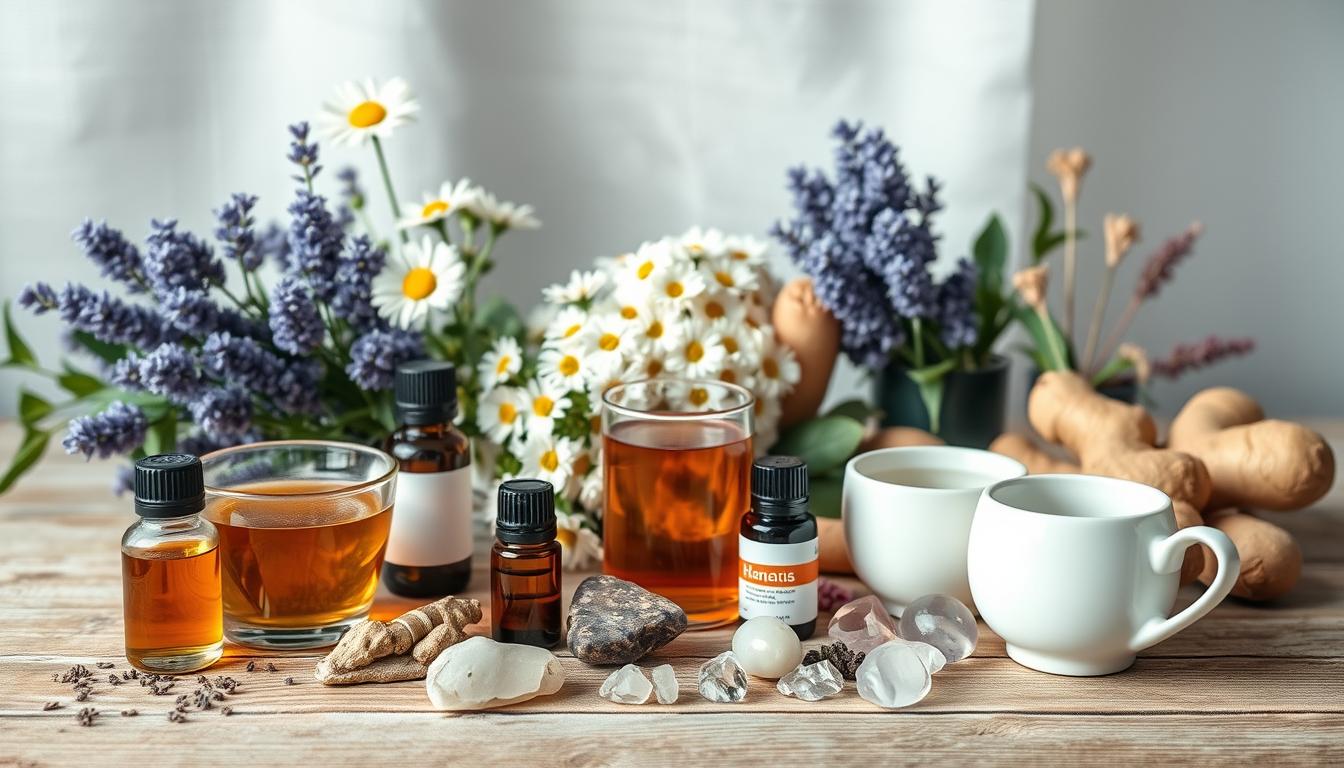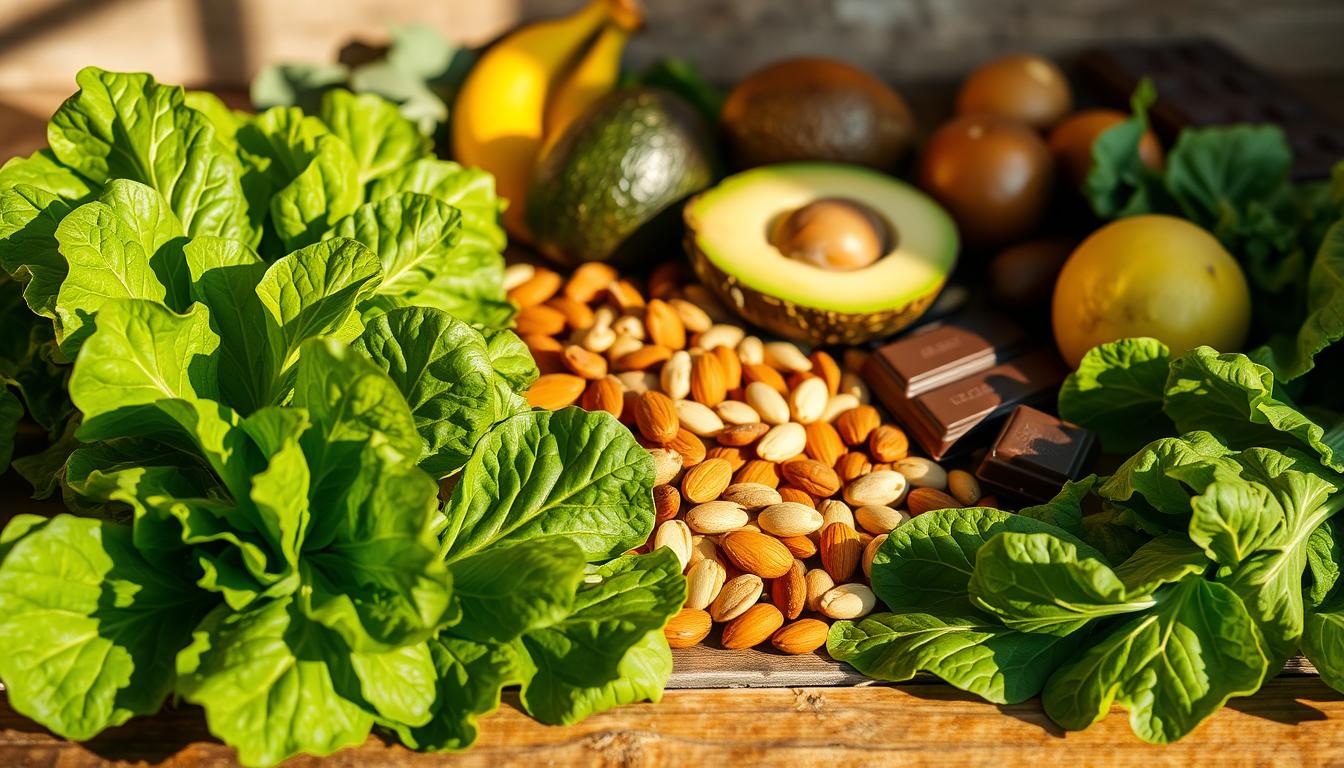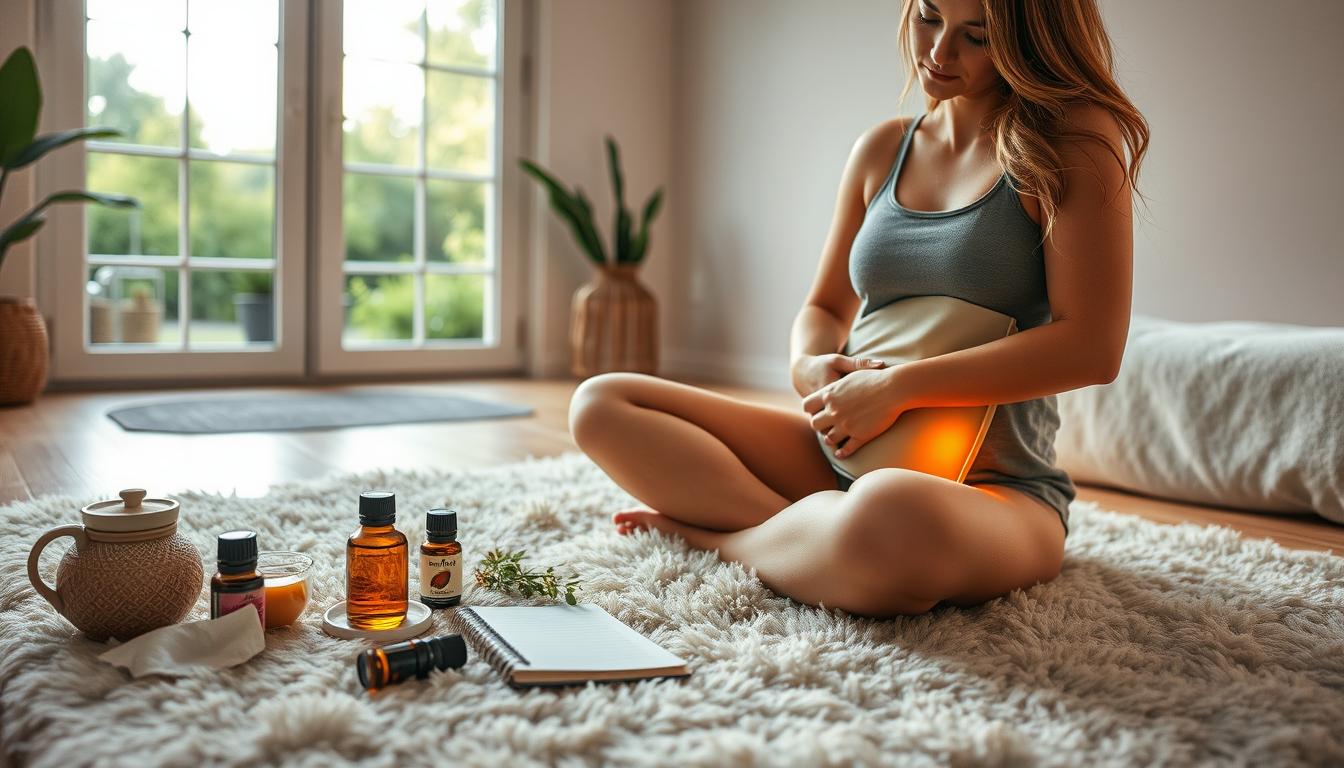Premenstrual Syndrome (PMS) is a mix of physical, emotional, and mental symptoms women face before their period. Symptoms include mood swings, bloating, cramps, fatigue, and irritability. These can really affect your daily life, so finding gentle solutions is key.
This article will share 3 tips to ease PMS discomfort. We focus on a holistic approach to PMS management. You’ll learn how to reduce discomfort with simple, daily methods, aiming for a peaceful and calming experience.
Key Takeaways
- Get familiar with the typical signs of PMS and how they can affect your daily life.
- Discover 3 natural tips for alleviating PMS discomfort.
- Discover simple ways to bring a natural, whole-body approach into your everyday habits.
- Find out how to manage PMS symptoms effectively and peacefully.
- Improve your overall well-being during the menstrual cycle.
Understanding PMS and Its Common Symptoms
It’s important to understand PMS to manage its symptoms well. Premenstrual syndrome (PMS) includes a mix of emotional, mental, and physical symptoms that often appear in the days leading up to your period.. These happen before your period starts.
What Happens During PMS
Hormonal changes during PMS cause various symptoms. A drop in estrogen and progesterone is often the main cause behind PMS symptoms. This affects different parts of the body.
Common Physical Symptoms
You might feel cramps, bloating, tender breasts, and be very tired. These symptoms can be different for everyone. These symptoms may interfere with your ability to focus or carry out routine activities.
Emotional and Psychological Effects
PMS can also affect your mood and mind. You might feel moody, irritable, anxious, or depressed. Knowing these symptoms is the first step to feeling better.
Mindfulness, controlled breathing, and stress-relief techniques can help ease emotional PMS symptoms.
Why Natural Remedies for PMS Relief Matter
PMS symptoms can really get in the way, but natural remedies offer a gentle way out. They don’t come with harsh side effects. It’s key to know the limits of regular treatments and the perks of natural methods.
Limitations of Conventional Treatments
Regular treatments for PMS often include meds with bad side effects. These might help for a bit but can cause problems later on. Natural remedies, on the other hand, aim for a better life overall.
Benefits of Holistic Approaches
Going holistic for PMS relief, like using herbal remedies and making lifestyle changes, is a smart move. It doesn’t just ease physical pain but also helps with emotional balance.
Creating a Sustainable Self-Care Routine
Adding natural remedies to your daily life can help manage PMS symptoms for good. It boosts both your physical and emotional health, making life more balanced.
Choosing natural remedies for PMS relief is a step towards a healthier, more sustainable you.
1. Nutritional Approaches to Ease PMS Symptoms
Your diet can help reduce PMS symptoms. Making smart food choices can ease discomfort and boost your health.
Magnesium-Rich Foods for Cramp Relief
Magnesium is key for easing menstrual cramps. Eating foods high in magnesium can offer a lot of relief.
Leafy Greens and Nuts
Spinach, kale, almonds, and cashews are great magnesium sources. Adding them to your meals can lessen cramp severity.
Dark Chocolate as a Therapeutic Option
Choosing dark chocolate with at least 70% cocoa can help ease cramps, thanks to its magnesium content.
Herbal Teas That Soothe Discomfort
Soothing herbal teas offer a gentle, natural option for managing PMS discomfort. They offer relaxation and digestive relief.
Chamomile for Relaxation
Chamomile tea is known for its calming effects. It helps reduce stress and improves sleep during your cycle.
Ginger for Digestive Relief
Ginger tea can ease digestive issues and nausea from PMS. Its anti-inflammatory properties also reduce pain.
Raspberry Leaf for Uterine Health
Raspberry leaf tea is full of nutrients. It can tone the uterus, reducing cramps and improving menstrual health.
Reducing Sugar and Caffeine Intake
Reducing your intake of sugar and caffeine may lessen the severity of PMS symptoms. It minimizes hormonal changes.
How These Substances Affect Hormones
Sugar and caffeine can worsen hormonal imbalances. This can lead to more symptoms like bloating and mood swings.
Healthy Substitutions
Swap sugary snacks for fruits and nuts. Choose herbal teas or decaf over caffeinated drinks to cut down intake.
2. Physical Relief Methods for PMS Discomfort
To fight PMS discomfort, try gentle exercises, heat therapy, and soothing essential oils. These methods can ease symptoms and boost your well-being during your menstrual cycle.
Gentle Exercise Routines
Gentle exercises can cut down on PMS symptoms by releasing endorphins. These chemicals make you feel better and less tired. Regular physical activity also helps keep your menstrual cycle in check.
Walking for Mood Enhancement
Walking is a great way to lift your mood during PMS. A quick 30-minute walk can release endorphins. This helps ease anxiety and depression symptoms.
Yoga Poses for PMS Relief
Some yoga poses target PMS symptoms directly. Downward-facing dog, child’s pose, and seated forward bend can ease cramps, back pain, and stomach tightness.
Heat Therapy Techniques
Heat therapy is also effective for PMS relief. Applying heat to your lower abdomen relaxes uterine muscles. This reduces cramps and pain.
Using Warm Compresses
A warm compress can ease cramps. Dip a towel in warm water, squeeze out the excess, and apply it to your lower belly for 15–20 minutes to relieve cramps.
Heating Pad Application Methods
Heating pads apply consistent heat to your abdomen. Use a heating pad on a low setting for 30 minutes to an hour. This helps relieve cramps and discomfort.
Essential Oils and Gentle Massage
Essential oils and gentle massage offer extra relief from PMS symptoms. Certain oils have anti-inflammatory and antispasmodic properties. They can ease cramps and discomfort.
Best Oils for PMS Relief
Clary sage, lavender, and chamomile oils are calming. They can reduce PMS symptoms. Use them in a diffuser or mix with a carrier oil for a soothing massage.
Self-Massage Techniques for Abdominal Comfort
Gently massaging your abdomen with essential oils can ease cramps. Use circular motions with your fingertips. This promotes relaxation and reduces discomfort.
3. Mind-Body Techniques for Emotional Balance
Managing PMS emotions needs a whole-body approach. Mind-body techniques help with both physical and emotional issues.
Mindfulness Practices During PMS
Mindfulness is a strong tool for PMS relief. It helps you stay present and control your symptoms.
5-Minute Meditation Exercises
Simple meditation can ease stress and anxiety. Just sit, focus on your breath, and release tension.
Mindful Awareness of Symptoms
Being mindful of symptoms means accepting them. It’s about acknowledging and accepting them as they are.
Deep Breathing Techniques
Deep breathing helps achieve emotional balance. It calms your mind and body.
4-7-8 Breathing Method
This technique has you inhale for 4 seconds, hold your breath for 7, then slowly exhale for 8 seconds. It’s a natural way to relax.
Belly Breathing for Cramp Relief
Belly breathing relaxes uterine muscles, easing cramps. Place one hand on your belly and the other on your chest, breathing deeply.
Stress Management Strategies
Knowing your stress triggers and creating a calm space are crucial for managing PMS stress.
Identifying PMS Triggers
Keep a journal to track symptoms and find patterns or triggers. This helps you prepare and manage better.
Creating a Calming Environment
Your environment affects your stress levels. Make a peaceful space with calming colors, soft lights, and soothing music.
Conclusion: Creating Your Personalized PMS Relief Plan
By adding the 3 natural tips from this article to your life, you can manage PMS better. You won’t need pills for period pain relief. Try changing your diet, using physical and mind-body techniques, and more.
When making your plan, think about what suits you best. Maybe a mix of magnesium-rich foods, gentle exercises, and stress control works for you. If PMS really gets in the way, talk to a healthcare expert for help.
With the right steps, you can feel better during your period. Taking a natural, whole-body approach to PMS may reduce discomfort and support overall well-being.









GIPHY App Key not set. Please check settings